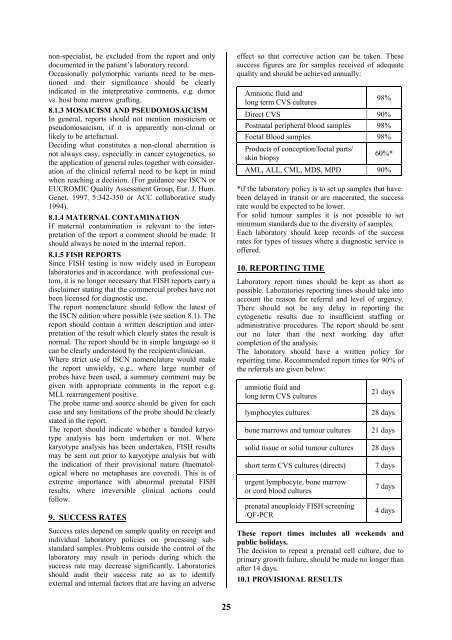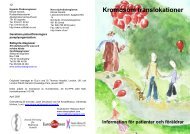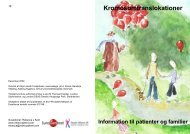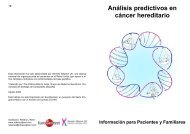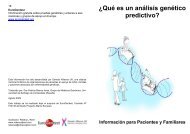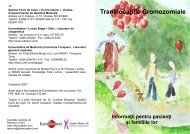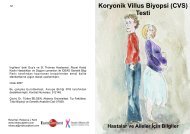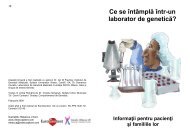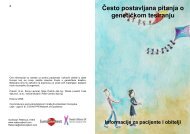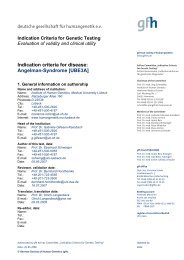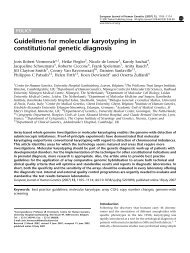Cytogenetic Guidelines and Quality Assurance - EuroGentest
Cytogenetic Guidelines and Quality Assurance - EuroGentest
Cytogenetic Guidelines and Quality Assurance - EuroGentest
You also want an ePaper? Increase the reach of your titles
YUMPU automatically turns print PDFs into web optimized ePapers that Google loves.
non-specialist, be excluded from the report <strong>and</strong> only<br />
documented in the patient’s laboratory record.<br />
Occasionally polymorphic variants need to be mentioned<br />
<strong>and</strong> their significance should be clearly<br />
indicated in the interpretative comments. e.g. donor<br />
vs. host bone marrow grafting.<br />
8.1.3 MOSAICISM AND PSEUDOMOSAICISM<br />
In general, reports should not mention mosaicism or<br />
pseudomosaicism, if it is apparently non-clonal or<br />
likely to be artefactual.<br />
Deciding what constitutes a non-clonal aberration is<br />
not always easy, especially in cancer cytogenetics, so<br />
the application of general rules together with consideration<br />
of the clinical referral need to be kept in mind<br />
when reaching a decision. (For guidance see ISCN or<br />
EUCROMIC <strong>Quality</strong> Assessment Group, Eur. J. Hum.<br />
Genet. 1997, 5:342-350 or ACC collaborative study<br />
1994).<br />
8.1.4 MATERNAL CONTAMINATION<br />
If maternal contamination is relevant to the interpretation<br />
of the report a comment should be made. It<br />
should always be noted in the internal report.<br />
8.1.5 FISH REPORTS<br />
Since FISH testing is now widely used in European<br />
laboratories <strong>and</strong> in accordance with professional custom,<br />
it is no longer necessary that FISH reports carry a<br />
disclaimer stating that the commercial probes have not<br />
been licensed for diagnostic use.<br />
The report nomenclature should follow the latest of<br />
the ISCN edition where possible (see section 8.1). The<br />
report should contain a written description <strong>and</strong> interpretation<br />
of the result which clearly states the result is<br />
normal. The report should be in simple language so it<br />
can be clearly understood by the recipient/clinician.<br />
Where strict use of ISCN nomenclature would make<br />
the report unwieldy, e.g., where large number of<br />
probes have been used, a summary comment may be<br />
given with appropriate comments in the report e.g.<br />
MLL rearrangement positive.<br />
The probe name <strong>and</strong> source should be given for each<br />
case <strong>and</strong> any limitations of the probe should be clearly<br />
stated in the report.<br />
The report should indicate whether a b<strong>and</strong>ed karyotype<br />
analysis has been undertaken or not. Where<br />
karyotype analysis has been undertaken, FISH results<br />
may be sent out prior to karyotype analysis but with<br />
the indication of their provisional nature (haematological<br />
where no metaphases are covered). This is of<br />
extreme importance with abnormal prenatal FISH<br />
results, where irreversible clinical actions could<br />
follow.<br />
9. SUCCESS RATES<br />
Success rates depend on sample quality on receipt <strong>and</strong><br />
individual laboratory policies on processing subst<strong>and</strong>ard<br />
samples. Problems outside the control of the<br />
laboratory may result in periods during which the<br />
success rate may decrease significantly. Laboratories<br />
should audit their success rate so as to identify<br />
external <strong>and</strong> internal factors that are having an adverse<br />
25<br />
effect so that corrective action can be taken. These<br />
success figures are for samples received of adequate<br />
quality <strong>and</strong> should be achieved annually:<br />
Amniotic fluid <strong>and</strong><br />
long term CVS cultures<br />
98%<br />
Direct CVS 90%<br />
Postnatal peripheral blood samples 98%<br />
Foetal Blood samples 98%<br />
Products of conception/foetal parts/<br />
skin biopsy<br />
60%*<br />
AML, ALL, CML, MDS, MPD 90%<br />
*if the laboratory policy is to set up samples that have<br />
been delayed in transit or are macerated, the success<br />
rate would be expected to be lower.<br />
For solid tumour samples it is not possible to set<br />
minimum st<strong>and</strong>ards due to the diversity of samples.<br />
Each laboratory should keep records of the success<br />
rates for types of tissues where a diagnostic service is<br />
offered.<br />
10. REPORTING TIME<br />
Laboratory report times should be kept as short as<br />
possible. Laboratories reporting times should take into<br />
account the reason for referral <strong>and</strong> level of urgency.<br />
There should not be any delay in reporting the<br />
cytogenetic results due to insufficient staffing or<br />
administrative procedures. The report should be sent<br />
out no later than the next working day after<br />
completion of the analysis.<br />
The laboratory should have a written policy for<br />
reporting time. Recommended report times for 90% of<br />
the referrals are given below:<br />
amniotic fluid <strong>and</strong><br />
long term CVS cultures<br />
21 days<br />
lymphocytes cultures 28 days<br />
bone marrows <strong>and</strong> tumour cultures 21 days<br />
solid tissue or solid tumour cultures 28 days<br />
short term CVS cultures (directs) 7 days<br />
urgent lymphocyte, bone marrow<br />
or cord blood cultures<br />
prenatal aneuploidy FISH screening<br />
/QF-PCR<br />
7 days<br />
4 days<br />
These report times includes all weekends <strong>and</strong><br />
public holidays.<br />
The decision to repeat a prenatal cell culture, due to<br />
primary growth failure, should be made no longer than<br />
after 14 days.<br />
10.1 PROVISIONAL RESULTS


